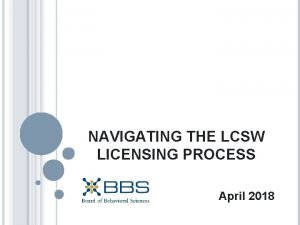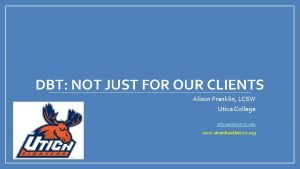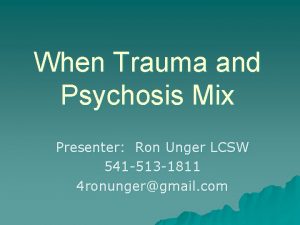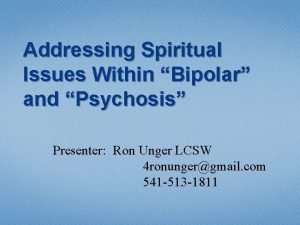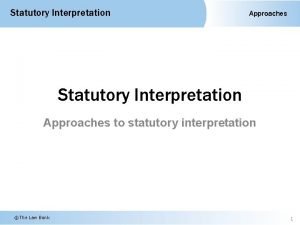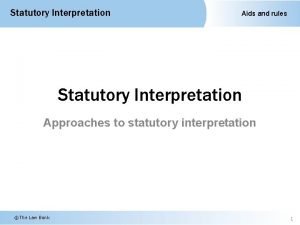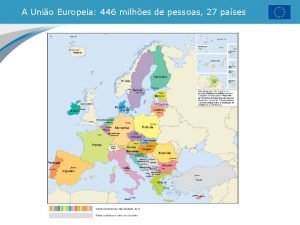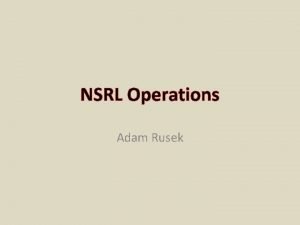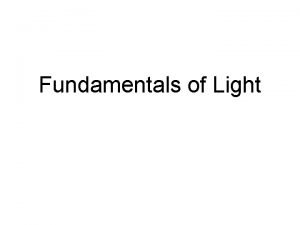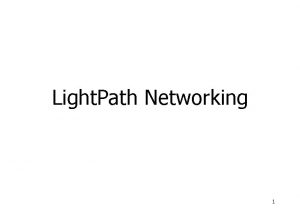Jack Light LCSW Jack Lightstjoe org 714 446



































- Slides: 35

Jack Light, LCSW Jack. Light@stjoe. org 714 -446 -5030

Objectives for Today • Learn the supportive resources for family caregivers; • Tools and strategies for aligning with the patient’s family caregiver in managing care. • Teaching simple interventions to family caregivers to address everyday care issues, i. e. dealing with a loved one with dementia. • Self-care for the care manager working with challenging families; professional wellness.

Former First Lady Rosalynn Carter "There are four kinds of people in this world: • those who have been caregivers, • those who currently are caregivers, • those who will be caregivers, • and those who will need caregivers. "

“Silver Tsunami” 10, 000 people a day are turning 65!

• 40 million caregivers in the United States provided unpaid care to older relatives and friends. • 3 in 10 people who are caring for someone say their life has changed, often negatively. • 1 in 5 says her weight, exercise habits, and/or social life have suffered. • 1 in 5 says she is generally unhappier, • 1 in 3 saying she feels sad or depressed. ” (AARP, 2015)

Definition of a Caregiver • Informal or family caregiver: is an unpaid individual (for example, a spouse, partner, family member, friend, or neighbor) involved in assisting others with activities of daily living and/or medical tasks. • Formal caregivers are paid care providers providing care in one's home or in a care setting (adult day care, residential facility, long -term care facility).

Caregiving • May involve: – helping with medical care, procedures and therapy – assisting with meals, personal care and transportation – providing emotional, mental and spiritual support – devoting just a few hours a week or around the clock care

Startling Statistics • Approximately 44 million Americans have provided unpaid care to an adult or child in the last 12 months • Approximately 40 million caregivers provide care to adults (aged 18+) with a disability or illness. This represents 17% of Americans • About 16 million adult family caregivers care for someone who has Alzheimer's disease or other dementia

Age & Gender • 65% of care recipients are female • 60% of caregivers are females • Spousal caregivers are the oldest: 63 years old • Males share more caregiving tasks than in the past • Females still shoulder the major burden of care

CG & Care Recipients • Parent care continues to be the primary caregiving situation for mid-life caregivers with 70% of the caregivers between the ages of 50 and 64

• Unpaid caregivers provide complex chronic care: – 46% perform medical and nursing tasks – More than 96% provide help with activities of daily living (ADLs)

Time Spent Caregiving • Average of 24 hours per week for 4 years • Older= more hours of CG

What is the Sandwich Generation? • The Sandwich Generation is a generation of people who care for their aging parents while supporting their own children. – Younger parents (30 -40’s) caring for their own minor children and aging parents – Middle aged parents (50 -60’s) caring for their grown children (more financial) and aging parents • Club Sandwich: Those in their 50’s-60’s sandwiched between aging parents, adult children and grandchildren, or those in their 30’s-40’s, with young children, aging parents and grandparents.

Sandwich Generation: Contributors • Increase in aging population • Generation of young adults struggling to achieve financial independence • Grandparents Raising Grandchildren – 2. 4 million grandparents raising 4. 5 million children

The Cost • Services provided by unpaid caregivers: estimated economic value of $470 billion in 2013 – up from $450 billion in 2009 and $375 billion in 2007 • The value of unpaid caregiving exceeded the value of paid home care and total Medicaid spending in the same year, and nearly matched the value of the sales of one of the world’s largest company, Wal-Mart ($477 billion) • The economic value of the care provided by unpaid caregivers of those with Alzheimer's disease or other dementias was $217. 7 billion in 2014

The Burden • Unpaid caregivers : positive activities in their respective daily lives are reduced by 27% • Burdens and responsibilities of middle-aged Americans are increasing: – Nearly half (47%) of adults in their 40 s and 50’s have a parent age 65 or older and are either raising a young child or financially supporting a grown child (age 18 or older). – About one-in-seven middle-aged adults (15%) is providing financial support to both an aging parent and a child • Pew Research: burden is more from grown children rather than aging parents – Boomerang children – Factors: recession and sluggish economy

Help for the Family CG Family Caregiver Resource Center Phone (800) 543 -8312 or (714) 446 -5030 www. caregiveroc. org

California Caregiver Resource Center System est. 1984 11 Caregiver Resource Centers

Family Caregiver Resource Center: Serving OC since 1988 Mission: “To Increase the Quality of Life of Caregivers by Helping Families and Communities Master the Challenges of Caregiving”

Our Mantra “Caregiving includes caring for me. ”

For family caregivers Education, Support and Counseling • Professional staff focusing on issues specific to successful family caregiving and self care. • Services are provided in a variety of modalities i. e. , individually, in groups and through a variety of events and classes. • Grants for respite and other services

For family caregivers Education, Support and Counseling • Professional staff focusing on issues specific to successful family caregiving and self care. • Services are provided in a variety of modalities i. e. , individually, in groups and through a variety of events and classes. • Legal Assistance & Advanced Directives • Grants for respite and other services

Family Dynamics • • Who is the caregiver (HIPAA) Expectations/Promises Family Personality Sibling issues Proximity Decision-making style Emotions

Start with the Dx for alignment • Ask the CG… “How are you? ” • Teach the CG about the patient’s condition and what to expect… • Discuss the new normal with the CG and ask how that affects them… • Establish a “new normal” mentality…

CG’s of Dementia Patients • Talk to CG’s about – Health care wishes - Advanced Directives – Finances - Estate Planning, Powers of Attorney 25

Avoiding Stress Simple intervention with a CG if the one they are caring for is cognitively impaired… please avoid: • Arguing • Reasoning • Explaining 26 A R E

Accept and Ask for Help • Develop the “LIST” – Honor those offering to help. – Help does not have to be directly related to care, but something that needs doing.

Health Consequences Caregivers can suffer tremendous negative physical health effects • As the care receiver’s health deteriorates, so does the potential for the caregiver’s.

-Eda Le. Shan. When we truly care for ourselves, it becomes possible to care far more profoundly about other people. The more alert and sensitive we are to our own needs, the more loving and generous we can be toward others.

Emotional Consequences • Caregivers potentially suffer tremendous negative emotional health effects – Stress – Anxiety – Depression 30

3 Underlying Beliefs for Self-Care • Caring for yourself will also benefit the person you care for • You can “thrive” not just “survive” as a caregiver • Feeling burned out is a choice – support and help is available

Resources • Family Caregiver Resource Center – www. caregiveroc. org/ – 714 -446 -5030 • National Alliance for Caregiving – www. caregiving. org/ • Caregiver Action Network – www. caregiveraction. org/ • AARP – www. careconnection. org – aarp. org/caregiving

Questions?

Sources for Stats • AARP Public Policy Institute. (2015). Valuing the Invaluable: 2015 Update • AARP and United Health Hospital Fund. (2012). Home Alone: Family Caregivers Providing Complex Chronic Care • Alzheimer's Association. (2015). 2015 Alzheimer's Disease Facts and Figures • Coughlin, J. (2010). Estimating the Impact of Caregiving and Employment on Well-Being: Outcomes & Insights in Health Management • Fisher, G. G. , Franks, M. M. , Plassman, B. L. , Brown, S. L. , Potter, G. G. , Llewellyn, D. , et al. (2011). Caring for Individuals with Dementia and Cognitive Impairment, not Dementia: Findings from the Aging, Demographics, and Memory Study

• Gallup-Healthways. (2011). Gallup-Healthways Well-Being Index • National Alliance for Caregiving and AARP. (2015). Caregiving in the U. S. • National Alliance for Caregiving and United Health Foundation. (2010). Caregivers of Veterans: Serving on the Home Front • Ramchand, R. , Tanielian, T. , Fisher, M. , Vaughan, C. , Trail, T. , Batka, C. , Voorhies, P. , Robbins, M. , Robinson, E. , & Ghosh. Dastidar, B. (2014). Key Facts and Statistics from the RAND Military Caregivers Study • Wagner, D. & Takagi, E. (2010). Health Affairs: Informal Caregiving by and for Older Adults
 Julie larson lcsw
Julie larson lcsw Bbs lcsw forms
Bbs lcsw forms Alison franklin
Alison franklin Ron unger lcsw
Ron unger lcsw Ron unger lcsw
Ron unger lcsw Julie larson lcsw
Julie larson lcsw Liedboek 425
Liedboek 425 452 en yakın onluğa yuvarlama
452 en yakın onluğa yuvarlama Deparated
Deparated Light light light chapter 22
Light light light chapter 22 Light light light chapter 22
Light light light chapter 22 Light light light chapter 23
Light light light chapter 23 Troop 446 pearland
Troop 446 pearland Purposive rule
Purposive rule 446 alta road suite 5300
446 alta road suite 5300 R v harris (1836)
R v harris (1836) O homem que calculava malba tahan
O homem que calculava malba tahan 446 pessoas
446 pessoas Hino sossegai
Hino sossegai Main characters of jack and the beanstalk
Main characters of jack and the beanstalk The bouncing off of light
The bouncing off of light Material that block light
Material that block light Put out that light
Put out that light Difference between light dependent and light independent
Difference between light dependent and light independent Jack tumblin
Jack tumblin Adam sandler jack black
Adam sandler jack black Genre of poetry
Genre of poetry Intersecting roofs
Intersecting roofs Fowler
Fowler Hi hi how are you doing
Hi hi how are you doing The rivals by sheridan as a comedy of manners
The rivals by sheridan as a comedy of manners Jack schmidli
Jack schmidli Food safety for immunocompromised patients
Food safety for immunocompromised patients Sasquatch beef sticks
Sasquatch beef sticks Dr jack lambert lyme disease
Dr jack lambert lyme disease Jack rusek
Jack rusek

